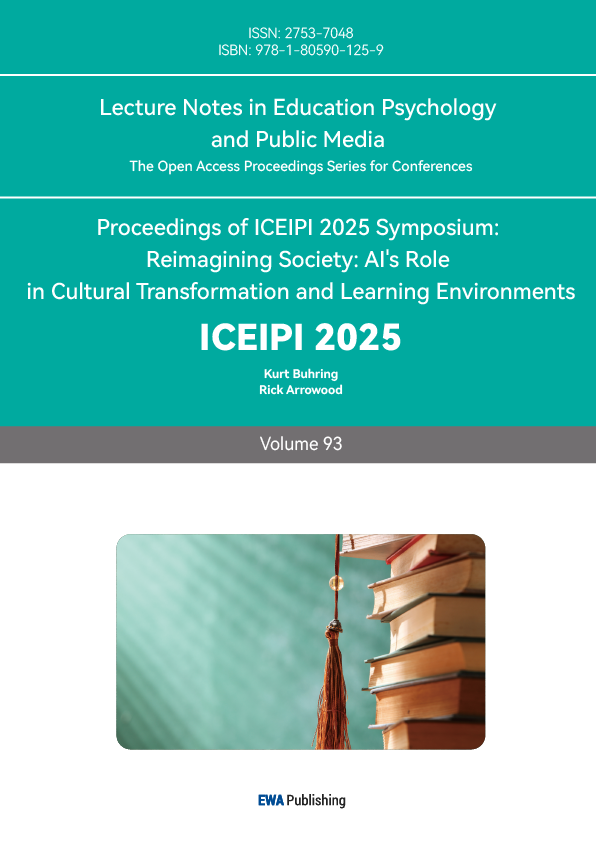1. Introduction
As the core platform for cultivating reserve talents in China’s competitive sports system, sports schools (hereinafter referred to as "sports schools") play a foundational role within the “three-tier training network.” As of 2023, there are 2,165 sports schools across the country, training a total of 538,000 athletes. Data show that at the 2020 Tokyo Olympics, 99% of Chinese medalists were trained in sports schools (113 out of 114 medal winners); at the 2022 Beijing Winter Olympics, 94% of the athletes who placed in the top eight of their events (46 out of 49) had a background in sports school training.[1] This clearly demonstrates the leading role and historical contribution of sports schools in China's competitive sports talent development. However, with the deepening implementation of the sports-education integration strategy, traditional sports schools are facing transformational challenges. On one hand, athletes trained by sports schools continue to achieve excellent results on the international stage; on the other hand, grassroots sports schools are encountering common difficulties in "recruiting and retaining students." This paradox—"glorious achievements" alongside "developmental concerns"—highlights the underlying structural issues faced by sports schools in the new era.[2] Therefore, under the broader framework of sports-education integration, how China’s sports schools can break through development bottlenecks, continue to nurture competitive sports talents, and achieve sustainable and healthy growth deserves greater attention.
2. Literature review
The establishment of sports schools marked a significant breakthrough in China’s sports development. Youth amateur sports training in China began to develop in the early years of the People's Republic, with the primary goal of cultivating reserve talent for competitive sports. In 1955, the State Sports Commission initiated youth sports training schools in Beijing, Tianjin, and Shanghai, signifying the initial formation of China’s youth sports training system.[3] Currently, there are a large number of sports schools nationwide, with substantial enrollment figures. These schools have achieved remarkable results in talent cultivation, particularly in international competitions such as the Tokyo Olympics and Beijing Winter Olympics, where the majority of Chinese medalists were trained in sports schools.[1]
However, with the evolution of the times, the operating model of sports schools has gradually shifted. While the traditional “three concentrations” model (centralized schooling, training, and living) still exists, a new “sports-education integration” model has become mainstream. This model integrates athletes into the regular or key school education system, enriching their academic experience and offering more possibilities for their holistic development. Yet, this shift has also brought new challenges, such as increased difficulty in student recruitment and declining training quality.[4]
Current research shows that many sports schools generally lack sufficient emphasis on cultural and academic education in the training of young basketball athletes. This deficiency is a key factor behind the shrinking scale of the “three-tier training system.”[5] The curriculum in sports schools remains overly simplistic and lacks alignment with modern society and current developmental trends. Moreover, the evaluation systems are underdeveloped, failing to comprehensively reflect students’ athletic literacy and physical and mental well-being.[6] These issues have led to difficulties for young basketball athletes in areas such as career planning and academic achievement, thereby affecting the cultivation and delivery of basketball reserve talents.[7] The situation is particularly dire in the development of young female basketball players, where problems such as recruitment difficulties, insufficient talent pool, inadequate coaching quality, poorly organized competitions, and lack of medical and logistical support are increasingly prominent.[8]
At present, research on sports schools under the context of sports-education integration remains insufficient. Firstly, there is a lack of empirical studies focusing on the development of sports schools within this integrated model. Secondly, the summarization of practical experiences of sports schools in this transformation process remains superficial. Lastly, further in-depth exploration is needed regarding strategies to optimize the development of sports schools under the framework of sports-education integration.
As a crucial talent pool for national and provincial elite athletes, the sustainable development and optimization of sports schools are of vital importance. Based on this understanding, this study investigates the training, academic, and daily life conditions of female basketball athletes in Guangdong sports schools. It aims to analyze the current state and challenges faced by China’s sports schools and propose targeted strategies to provide constructive recommendations for their future development.
3. Research subjects and methods
3.1. Research subjects
This study focuses on the athletes from the top six teams in the 2023 Guangdong Youth Women’s Basketball Championship. These teams include those from Shenzhen Sports School, Guangzhou Weiren Sports School, Dongguan Sports School, Foshan Sports School, Jiangmen Sports School, and Zhongshan Sports School. The researcher served as the head coach of the Dongguan Women’s Basketball Team at Dongguan Sports School in 2023. Through involvement in daily training management, participation in the Guangdong Youth Basketball Championship, and various exchange competitions across the province, the researcher maintained close communication and cooperation with coaches from the other five teams. This enabled systematic observation and documentation of training models, academic-athletic integration structures, and athlete development conditions. Additionally, through verbal interviews with head coaches from the aforementioned schools, the study gathered first-hand data and professional insights on the training of youth female basketball athletes in sports schools, providing a reliable foundation of data and theoretical reference.
3.2. Research methods
Literature Review Method: By reviewing relevant academic literature, policy documents, and statistical reports from both domestic and international sources, this study systematically outlines the development of sports schools, the policy background of academic-athletic integration, and the current status of youth basketball training. Literature sources include CNKI (China National Knowledge Infrastructure), Web of Science, and the official website of the General Administration of Sport of China. The literature review established the theoretical framework of the research and informed the design of questionnaires and interview guides.
Questionnaire Survey Method: The study distributed questionnaires to players from the top six teams in the 2023 Guangdong Youth Women’s Basketball Championship, focusing on four core dimensions: training conditions, academic learning, competition participation, and daily life management. The questionnaire adopted a combination of a five-point Likert scale and open-ended questions. A total of 165 questionnaires were distributed, and 162 valid responses were collected, resulting in a valid response rate of 98.2%. The data served as the foundation for quantitative analysis.
Interview Method: Semi-structured interviews were conducted with head coaches from the six sports schools (Shenzhen, Guangzhou Weiren, Dongguan, Foshan, Jiangmen, and Zhongshan). Interview topics centered on training models and challenges for female basketball players in sports schools, manifestations and resolutions of conflicts between academics and training, the impact of the competition system on athlete development, and the implementation of academic-athletic integration policies. The interview data, after being organized, were used to supplement the questionnaire results and provide a basis for qualitative analysis.
Observation Method: As the head coach of the Dongguan Women’s Basketball Team, the researcher employed participatory observation to record players’ daily training, academic classes, life management, and game performance. Key observation areas included: the scientific design and execution of training plans; student-athletes’ engagement and adaptability in academic learning; performance and psychological state during competitions; and the organization and satisfaction level of extracurricular life. The observational data were recorded in field notes and used to cross-validate questionnaire and interview findings.
Data Analysis Method: Excel was used to organize and analyze the questionnaire data. The process included: (1) data cleaning—removal of invalid responses and unified coding; (2) descriptive statistics—calculation of percentages and means to present distributions across dimensions; (3) cross-analysis—to explore relationships among variables; and (4) visualization—presentation of results through pie charts. These analyses provided empirical support for the study’s conclusions and recommendations.
4. Results and analysis
4.1. Overview of female basketball players in sports schools
Survey results show that 64.25% of female basketball players in sports schools are between the ages of 12 and 15, primarily in junior high school. In contrast, only 22.6% are between 15 and 18 years old, representing merely one-third of the younger group, indicating a significant attrition of athletes in the senior high school age group. Analysis suggests that this stage marks a crucial turning point in athlete development: a few outstanding players move on to higher-level teams for more professional training and guidance, while the majority, facing uncertain prospects in basketball and increased academic pressure, shift focus to cultural studies. This divergence in developmental paths results in a sharp decline in athlete numbers at the senior high level.
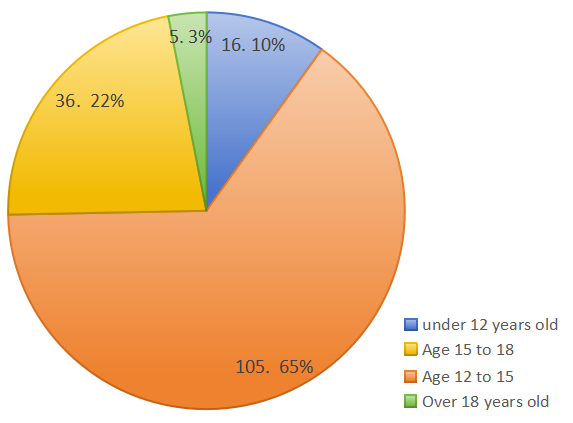
Additionally, more than 10% of the players are under the age of 12, raising concerns about early specialization. At this developmental stage, children are undergoing key physical and psychological growth, and premature specialized training may adversely affect their overall development.[9] Regarding training experience, 73.4% of players have less than three years of systematic training, indicating that most are still in the early stages of basketball skill development. Furthermore, 24% have trained for 3–6 years, with 43.5% of these in the 12–15 age range, further confirming the issue of early specialization.
4.2. Current training conditions and analysis
In terms of training hours, the data show that female basketball players in sports schools have relatively long training sessions, with 30.2% training over 30 hours per week. Among these, 73.4% are under 15 years old. Excessive training time may increase the risk of overtraining, resulting in injuries, chronic fatigue, and even affecting the physical development of young athletes. Moreover, the high proportion of young athletes intensifies potential health risks. Early specialization may also reduce motivation and enjoyment. This phenomenon may stem from performance-oriented training models, selection mechanisms that equate effort with training duration, and the misconception held by some coaches and parents that "more training equals better results."
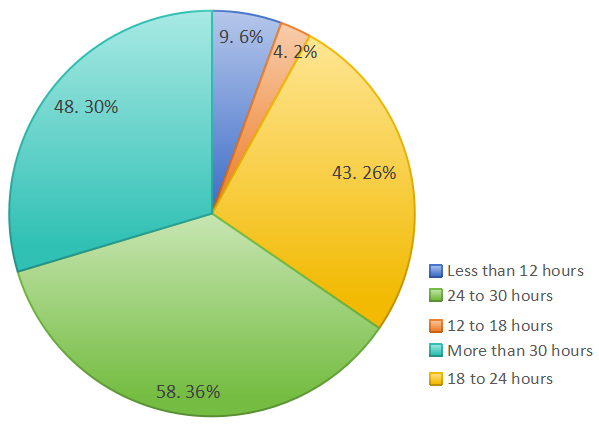
Despite these concerns, player satisfaction with training is generally high. Over 80% of athletes believe they receive adequate guidance and feedback during training. Additionally, 88.3% are satisfied with team collaboration and training atmosphere. This strong sense of team cohesion is attributed to coaches’ emphasis on team culture, which fosters belonging through shared goals and motivational teaching strategies.
Regarding training facilities, 30% of players suggested improvements in equipment and conditions, while 70% expressed a desire for more personalized training programs. The current system emphasizes repetition to strengthen basic skills—a valid approach for foundational development. However, as sports science evolves, training philosophies are shifting toward accommodating individual differences, such as skeletal-muscular development and psychological adaptation. Although basic training equipment is largely adequate, improvements are still needed in functional equipment, recovery tools, and digital performance analysis systems.
4.3. Current academic learning conditions and analysis
According to the data, 75.8% of athletes study more than 20 hours per week, with 30.8% exceeding 30 hours. However, 24% study fewer than 20 hours weekly, 81.9% of whom are under 15. Their academic time is often compromised due to impromptu training games, call-ups for higher-level training, and external competitions. The lack of consistent learning schedules may cause gaps in subjects requiring continuity, such as math and English, thus eroding both confidence and motivation.
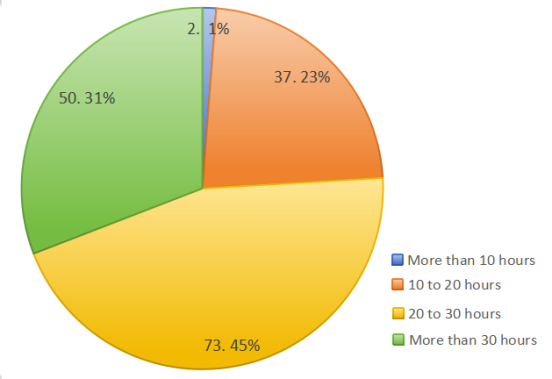
There is also a clear mismatch between the demand and supply of tutoring. The survey shows that 57.5% of players need extra tutoring. Irregular training and competition schedules lead to scattered absences, making traditional tutoring ineffective. Teachers struggle to meet fragmented demands due to workload limits, and existing teaching resources cannot cover all students. Moreover, sports school curricula often replicate those of mainstream schools without adaptation to athletes’ specific needs—failing to address conflicts between training and learning or to provide flexible learning plans for athletes frequently absent for competitions.
Furthermore, 42.2% of students cannot effectively utilize available school or online resources for self-directed learning, and satisfaction with learning resources is a mere 8.6%. This highlights not only inadequate investment in educational infrastructure but also a lack of student initiative and self-learning capacity, ultimately limiting academic performance.
4.4. Competition participation status and analysis
Currently, 87% of players participate in fewer than 20 games per year, and 54.3% play in fewer than 10. This is in stark contrast with Guangdong’s reputation as a basketball powerhouse. According to the U.S. Youth Basketball Guidelines, players aged 12–14 should compete twice a week.[10] The competition frequency at present falls short of young players’ developmental needs.
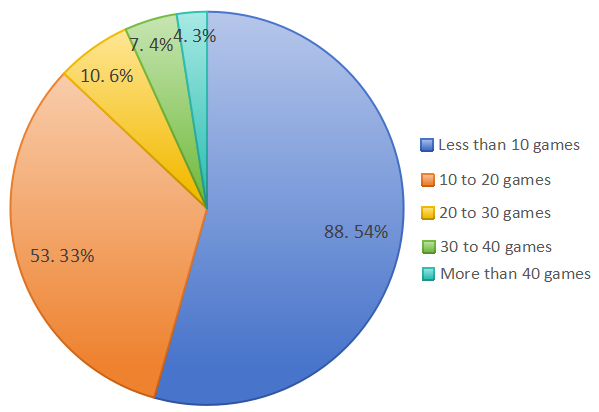
The main reason for this lies in structural deficiencies in grassroots competition systems. Professional competition frameworks have not sufficiently expanded to reach youth teams, and school leagues lack proper integration with professional training programs. From a developmental standpoint, moderate competition frequency is vital: matches test training outcomes and improve tactical awareness and adaptability, while well-planned schedules sustain motivation and prevent burnout from repetitive training.
4.5. Life management status and analysis
Only 40% of athletes believe they have enough leisure time for social and recreational activities, while 75.3% hope the schools will offer more extracurricular options to relieve academic and training stress. This reflects how training schedules encroach on students’ free time. From a developmental psychology perspective, appropriate leisure activities are crucial for improving social skills, emotional regulation, and creativity.
Although 73.3% maintain good dietary habits, 70.9% hope for more varied meal options. Sports schools, in prioritizing nutrition and food safety (e.g., avoiding banned substances), often serve repetitive menus. While this ensures basic nutritional needs, it may lower overall satisfaction with meals.
Of note, 16.6% of athletes report mental health issues—74% of whom train more than 24 hours per week. Additionally, 35.1% of players express a need for psychological counseling, with 75.4% under the age of 15. Sleep deprivation is another concern, affecting 19% of athletes—88.8% of whom are under 15. These findings suggest that sustained high-intensity training, academic pressure, and limited personal time may contribute to psychological stress. While athletes appear open to mental health support, current systems do not fully meet their needs.
5. Recommendations
5.1. Control training duration, optimize training structure, and build a scientific training system
Training intensity and duration for younger athletes should be strictly aligned with developmental guidelines to prevent premature specialization. Coaches should tailor training plans based on individual differences and incorporate scientific approaches such as functional training and recovery care. Training infrastructure should be improved, with increased investment in digital analysis systems and sports science equipment to support data-driven, scientific training.
5.2. Implement flexible teaching and resource integration to address academic-training conflicts
Develop tailored curricula for student-athletes and create fragmented learning resources, such as online courses, to bridge learning gaps during training and competitions. Encourage collaboration between educators and coaches through regular communication and coordinated planning of training and competition schedules. Provide intensive tutoring in subjects frequently missed due to absences. Additionally, foster students' independent learning skills and improve the accessibility and usability of learning resources, including libraries and digital devices.
5.3. Promote training through competition, introduce tiered competitions, and improve system integration
Partner with educational and sports authorities to establish a grassroots youth league system, with tiered and regular competitions such as municipal, district, and county-level U12–U18 leagues. Organize regular intra-squad matches to simulate real-game conditions and enhance competitiveness. Increase support for school teams participating in external competitions by ensuring adequate funding and logistics. Incorporate competitive performance into training assessments to create a virtuous cycle of "training–competition–feedback–improvement."
5.4. Emphasize psychological support and life balance, and promote humane life management
Establish a systematic mental health support mechanism, including offering mental health education, appointing dedicated counselors, and conducting regular psychological assessments for athletes with high training loads. Diversify extracurricular activities to include arts, community service, and other enrichment programs to ensure athletes have sufficient time for relaxation and personal development. In dietary management, while maintaining nutritional balance and food safety, menus should be adjusted to enhance variety. Finally, develop rest schedules aligned with adolescent growth patterns, with a focus on monitoring and ensuring adequate sleep and recovery time.
6. Conclusion
Current training practices for female basketball players in sports schools show issues such as excessive training hours and a trend toward early specialization. Some athletes train more than 30 hours per week, particularly those under 15 years old, which may adversely affect their physical and mental development. Although players report high satisfaction with training content and team atmosphere, the availability of training facilities and individualized training programs remains insufficient. This reflects a continued reliance on traditional, repetitive training models that have not fully integrated advancements in sports science.
Academic learning is frequently squeezed by training and competition schedules. Some athletes study less than 20 hours per week, with a higher proportion among younger students. The current education system lacks flexibility, making it difficult to accommodate athletes’ frequent absences due to external training and competitions, thereby disrupting academic continuity. Furthermore, mismatches in tutoring supply and demand, inadequate school infrastructure, and limited self-directed learning capacity have collectively hindered academic performance.
Players generally participate in a low number of competitions annually, with most playing fewer than 20 games per year. The grassroots competition system fails to align with professional training needs. The lack of competitive opportunities not only restricts the development of game-specific skills but may also dampen players’ long-term motivation and sense of purpose in training.
Athletes’ leisure time is limited, and extracurricular activities are monotonous, failing to meet the developmental needs of adolescents in terms of social interaction and psychological growth. While dietary arrangements meet basic nutritional standards, variety is lacking. In addition, the existing psychological support system does not fully address player needs. Some athletes experience sleep deprivation and psychological stress, highlighting the need for a more comprehensive mental health support mechanism.



